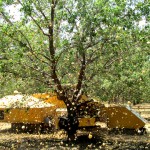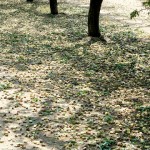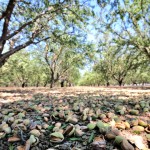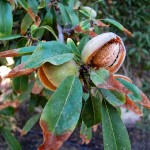This report covers conditions and observations made between Monday, July 1 and Sunday August 4, 2013. The next report is scheduled for Monday, September 2, 2013. However, in the event of any significant occurrences prior to that date, this site will be updated as soon as possible.



This report covers conditions and observations made between Monday, July 1 and Sunday August 4, 2013. The next report is scheduled for Monday, September 2, 2013. However, in the event of any significant occurrences prior to that date, this site will be updated as soon as possible.
Northern Region –
The first of our photos for the northern region shows the drying hulls of the Nonpareil almonds in the Orland area of Glenn County waiting for the harvest, while our second image documents the start of almond harvest operations in the Arbuckle area of Colusa County as a side-mount shaker removes the crop from a Nonpareil planting, followed by the nuts laying on the ground to dry prior to being swept and picked up.
Continuing the heat wave experienced in the last week of June, daily maximum temperatures reached to uncomfortable levels from 105 to 108 degree during the first days of July, increasing stress levels on the maturing crop, as well as on the valley’s residents. Fortunately, the very hot temperatures abated shortly after the 4th of July holiday, rising to more comfortable levels between the upper 80’s and upper 90’s for the balance of the period. Morning minimum temperatures followed a similar trend, dipping only into the low to mid 70’s as the period began and retreating back into the mid 50’s to mid 60’s for the majority of the period. Monsoonal moisture that increased humidity levels in the central and southern regions also made its presence known in the Sacramento Valley. However, the moisture provided comparatively little impact on the region’s weather.
Growers attention during the period was focused on completion of the various tasks required prior to the start of the 2013 harvest. Irrigation was a prime activity during the period as growers worked to balance the desire to induce a slight degree of stress at the initiation of the hull split against the need to provide ample water required to counter stress imposed by the warmest days at the start of the period. Observers reported that the hull split began normally, if not earlier than in recent years, then seemingly came to an abrupt halt as daytime temperatures reached their highest levels imposing an excessive degree of stress on the trees. The normal progression of the hull split then resumed as temperatures receded to more normal levels. Observers are now reporting varying degrees of hull split on all varieties except for Mission, Padre and Fritz. Also noted is the apparently heavy shell and thick hulls observed in many of the region’s plantings. The heavy shell and commensurate good shell seal give growers hope of lower reject levels from both Navel Orange Worm, NOW, and ants. While treatments to control NOW “flights” that can impact early harvesting varieties have been completed, growers are now monitoring pheromone traps for timing of the next “flight” poised to start at mid-August. Growers hope to avoid additional treatments, but must monitor the insect’s life cycle in order to ensure good crop quality. Treatments with bait formulations targeted at offending ant species are also being completed. However, problems from web-spinning mites have been at a minimum this year, with few orchards having significant populations.
Growers sent shakers into the first orchards to be harvested during the final week of the period. However, shaking will not begin in earnest until the first full week of August. Observers have noted that shaking of the first orchards appeared to go quite well, with good nut removal and very few, if any nuts remaining in the trees. All are hoping that this pattern will continue throughout the harvest.
Throughout the region, growers are preparing their equipment and are poised to bring to harvest to a feverish pace as soon as their orchards are ready.
Central Region –
This report’s photos for the central region show the start of the harvest in the Tracy area of San Joaquin County as a side-mount shaker moves through an orchard, followed by the nuts drying on the orchard floor and finally, the splitting hulls of the Independence variety waiting to be shaken.



Variable and occasionally hot temperatures dominated the weather in the central region during July. Skies were mostly clear during the month, with periods of cloudiness produced by several pulses of monsoonal moisture that traveled northward from Mexico. While the greatest impact from the moist air was a noticeable and uncomfortable increase in humidity levels, a few thunderstorms were generated that dropped sparing amounts of rainfall on the valley floor at mid-month. Daily maximum temperatures varied greatly, with highest temperatures reported over the century mark in the period’s opening days as the heat wave experienced during last week of June continued to exert its influence. Readings moderated significantly after the 4th of July holiday, ranging from the upper 80’s to mid and upper 90’s for the balance of the period. Morning lows were reported at their warmest levels in the mid and upper 60’s to just over 70 degrees in the period’s opening days. Readings then dropped to the mid 50’s to mid 60’s for the balance of the period.
Growers spent much of the period focused on pre-harvest activities. Irrigation and weed control have been prime activities during the period as they prepared the orchards for the upcoming harvest. With the initiation of the hull split, those with sprinkler, drip or micro sprinkler irrigation systems withheld water to 50% of consumptive use in an effort to reduce the potential for infection of fungal organisms on the splitting hulls. This period coincided with the warmest temperatures of month, making close management a bit more difficult as growers do not want to subject their plantings in too much stress, which can adversely affect the crop. In spite of grower’s best efforts, the high temperatures created enough stress to seemingly stop the progression of the hull split at the start of the period. However, moderating temperatures and renewed irrigations allowed the split to resume its normal pace by mid-month. Growers have been very protective of their limited water supplies this year, wanting to retain enough to provide the irrigations needed after the harvest.
Hull split treatments for the control of Navel Orange Worm, NOW, have been completed, as have miticide treatments to a few orchards having populations that built to damaging levels. While mild infestations requiring treatment can be found around the region, the northern San Joaquin Valley has largely escaped the serious difficulties encountered by many producers in the southern San Joaquin. There has been much discussion this year regarding the large number of NOW moths captured in the newly available pheromone traps. When combined with poor conditions for winter sanitation during the past winter, which left a high number of mummy nuts in many of the region’s orchards, this has produced a bit of anxiety among growers as they consider potential reject levels in the crop. However, observers are reporting that the shell seal among the nuts to split thus far appears to be quite good. This will go a long way towards inhibiting the NOW’s ability to reach the kernel and portends of potentially low reject damage levels.
As the time for shaking comes closer, final preparations include mowing of the orchard floor to ensure efficient nut removal and treatments with ant bait formulations in orchards having excessively high populations of damaging species. Oil feeding ants are very attracted to the almonds as they lay on the ground after shaking and can inflict significant crop losses as a result of their feeding should the nuts have any opening in the shell. As mentioned above, shell seal is an important factor, which is unfortunately beyond a grower’s control.
With the shaking of the first orchards along the I-5 corridor during the last week of the period, harvest operations have begun in the central region. As is normally the case, Nonpareil orchards were the first to be shaken. However, harvest of the Independence, Price and Sonora along the west side will also begin shortly. Most growers report that they expect to begin shaking orchards along the eastern foothills within about two weeks, with those along the Highway 99 corridor planning on starting about one week later. However, some have already begun shaking of the most advanced or stressed plantings. Observers report that hull split has also begun in several pollenizer varieties, including Price, Sonora, Aldrich, with hulls on advanced Padre plantings along the west side also showing the first signs of splitting.
Southern Region –
This report’s photos for the southern region show a shaker removing the crop from a young planting in Madera County and the windrowed nuts waiting to be picked up in Kern County. Our final image shows the degree of hull split visible in the Padre variety in Kern County in a planting also showing the leaf burn caused by excessive salinity levels.



Hot to very hot temperatures dominated the conditions during July in the southern San Joaquin Valley, with a mild respite in the period’s closing days. Daily maximum temperatures reached to as high as 110 degrees during the first days of the month, continuing the heat wave that began in the previous period. Temperatures moderated slightly as the days progressed, dipping into the lower 90 during the milder days of the month and reaching a few degrees over the century mark on the warmest. Morning lows followed a similar trend, remaining at uncomfortable levels in the mid and upper 70’s during the warmest days and ranging from the lower 60’s to lower 70’s for much of the period. Monsoonal moisture coursing northward from Mexico created uncomfortable humidity levels on several occasions during the month and spawned a few afternoon thunderstorms as well, most notably over the Sierra Nevada Mountains.
Pre-harvest activities dominated grower’s attention during July as they prepared for the upcoming harvest. Irrigation and control measures for mites and Navel Orange Worm drew the greatest amount of attention as growers worked against the high temperatures to manage moisture levels while working to reduce the incidence of fungal infections on the splitting hulls. Many have been fighting increasing populations of web-spinning mites for several weeks, particularly in the Kern and Tulare County, but also in areas of Fresno County as well. Heaviest infestations have resulted in a degree of defoliation in many plantings in those areas. Growers have completed treatments for Navel Orange Worm and will be working to complete shaking of their most susceptible varieties prior to the initiation of the next flight of adult moths in an effort to reduce the degree of rejected kernels in the crop. Ant bait applications have also been conducted by growers with excessive populations of damaging species.
As shown in the photos accompanying this report, harvest operations have begun in the southern region, with the first orchard of the year shaken on July 19th northeast of Bakersfield in Kern County. Since that time, observers have noted that the pace of operations has increased steadily in orchards throughout Kern and Tulare counties. Shakers also began moving through orchards in western Fresno and Madera counties in the closing days of July. The combined effects of deficit irrigation practices, heavy mite pressure and the increasing levels of salinity have accelerated harvest dates in many southern region plantings. As a result, growers are anticipating moving through their orchards at a fairly brisk pace. While many in the region expecting to begin shaking within the next two weeks, the first product shaken was picked up and delivered to the huller/sheller in the period’s closing days.
Many growers are hoping to squeeze in irrigation after removing the Nonpareil and prior to shaking their pollenizer varieties. Growers are being very judicious in their irrigations this year, wanting to conserve ample water needed for the all-important post harvest irrigation needed to support the now differentiating flowers buds forming for the 2014 crop.